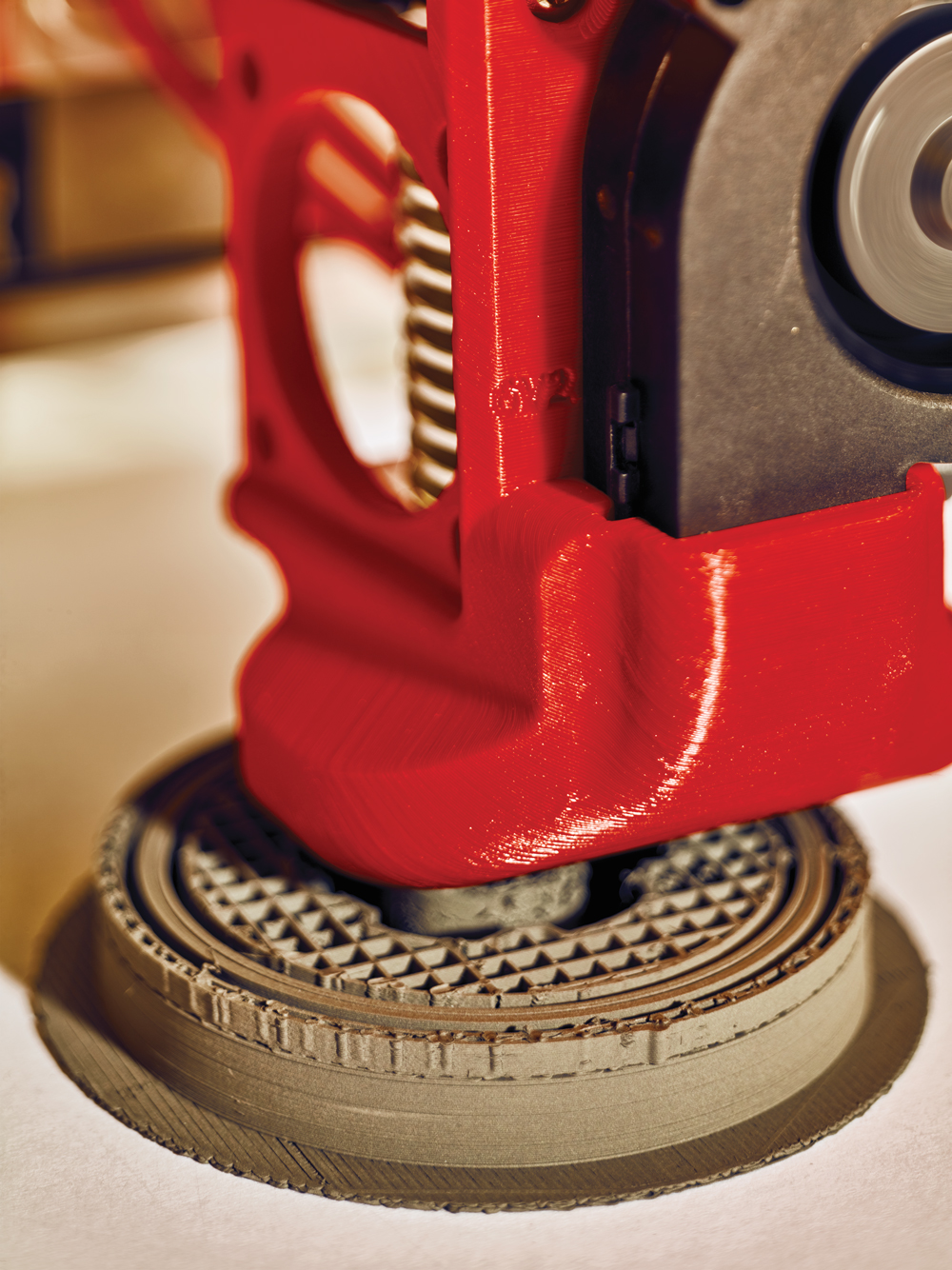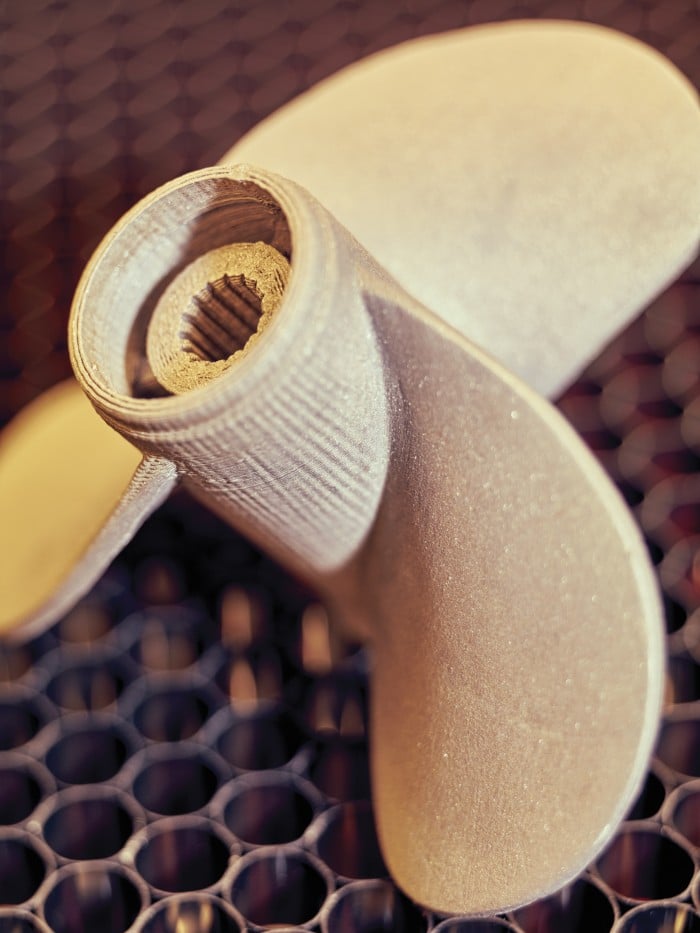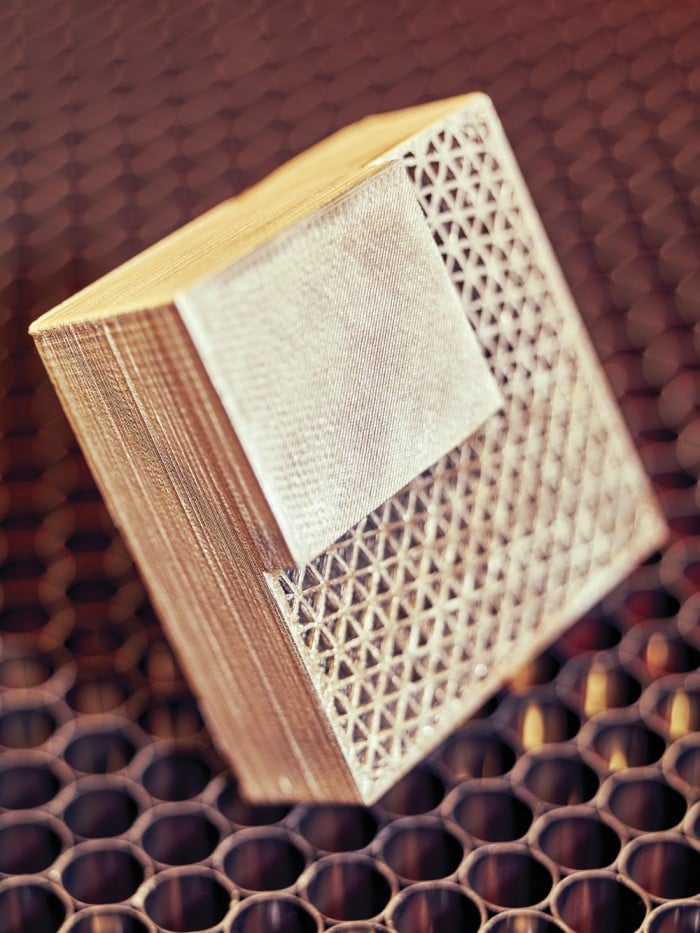The 3-D Printer That Could Finally Change Manufacturing

It’s less than two months before his company’s initial product launch, and CEO Ric Fulop is excitedly showing off rows of stripped-down 3-D printers, several bulky microwave furnaces, and assorted small metal objects on a table for display. Behind a closed door, a team of industrial designers sit around a shared work desk, each facing a large screen. The wall behind them is papered with various possible looks for the startup’s ambitious products: 3-D printers that can fabricate metal parts cheaply and quickly enough to make the technology practical for widespread use in product design and manufacturing.
The company, Desktop Metal, has raised nearly $100 million from leading venture capital firms and the venture units of such companies as General Electric, BMW, and Alphabet. The founders include four prominent MIT professors, including the head of the school’s department of materials science and Emanuel Sachs, who filed one of the original patents on 3-D printing in 1989. Still, despite all the money and expertise, there’s no guarantee the company will succeed in its goal of reinventing how we make metal parts—and thus transforming much of manufacturing.
As Fulop moves about the large, open workspace, his excitement and enthusiasm seem tempered by anxiety. The final commercial printers are not yet ready. Employees are busy tinkering with the machines, and fabricated test objects are scattered about. Progress is being made, but it’s also obvious that the clock is ticking. In a corner near the front door and entrance area, the floor is empty and taped off; soon the space needs to be filled with a mockup of the company’s planned booth for an upcoming trade show.
If it succeeds, Desktop Metal will help solve a daunting challenge that has eluded developers of 3-D printing for more than three decades, severely limiting the technology’s impact. Indeed, despite considerable fanfare and evangelical enthusiasts, 3-D printing has, in many ways, been a disappointment.
Hobbyists and self-proclaimed makers can use relatively inexpensive 3-D printers to make wonderfully complex and ingenious shapes out of plastics. And some designers and engineers have found those machines useful in mocking up potential products, but printing polymer parts has found little use on the production floor in anything but a few specialized products, such as customized hearing aids and dental implants.
Though it is possible to
3-D-print metals, doing so is difficult and pricey.
Though it is possible to 3-D-print metals, doing so is difficult and pricey. Advanced manufacturing companies such as GE are using very expensive machines with specialized high-power lasers to make a few high-value parts (see “Additive Manufacturing” in our 10 Breakthrough Technologies list of 2013). But printing metals is limited to companies with millions to spend on the equipment, facilities to power the lasers, and highly trained technicians to run it all. And there is still no readily available option for those who want to print various iterations of a metal part during the process of product design and development.

The shortcomings of 3-D printing mean the vision that has long excited its advocates remains elusive. They would like to create a digital design, print out prototypes that they could test and refine, and then use the digital file of the optimized version to create a commercial product or part out of the same material whenever they hit “make” on a 3-D printer. Having an affordable and fast way to print metal parts would be an important step in making this vision a reality.
It would give designers more freedom, allowing them to create and test parts and devices with complex shapes that can’t be made easily with any other production method—say, an intricate aluminum lattice or a metal object with internal cavities. It could eventually enable engineers and materials scientists to create parts with new functions and properties by depositing various combinations of materials—for example, printing out a magnetic metal next to a nonmagnetic one. Beyond that, it would redefine the economics of mass production, because the cost of printing something would be the same regardless of how many items were produced. That would change how manufacturers think about the size of factories, the need for backup inventory (why keep many parts in stock if you can simply and quickly print one out?), and the process of tailoring manufacturing to specialized products.
This is why there has been a race to turn 3-D printing into a new way to produce parts. Longtime suppliers of 3-D printers, including Stratasys and 3D Systems, are introducing increasingly advanced machines that are fast enough for manufacturers to use. Last year, HP introduced a line of 3-D printers that the company says will allow manufacturers to prototype and make products with nylon, a widely used thermoplastic. And last fall, GE spent over a billion dollars on a pair of European companies specializing in 3-D-printing of metal parts.


But the real competition for Desktop Metal is probably not from the growing number of companies in 3-D printing. For one thing, the 3-D printers from HP, Stratasys (an investor in Desktop Metal), and 3D Systems mainly use various types of plastics, not the range of metals Fulop’s company wants to use in its printers. And GE’s high-end machines overlap little with Desktop Metal’s market ambitions. Instead, the real competitors for Desktop Metal are more likely to be established metal-processing technologies. Those include automated machining techniques—such as the method used to make the ultra-thin aluminum back casing of iPhones—and a rapidly growing practice called metal injection molding, a common way to mass-produce metal products.
Key Players in 3-D printing
Company: Stratasys
Technology: One of the original 3-D-printing companies, Stratasys was founded by Scott Crumb, the inventor of fused deposition modeling, the most common way to print plastic parts.
Products: Sells machines that can print a variety of photopolymer and thermoplastic materials.Company: Carbon
Technology:This Silicon Valley startup has developed a novel photochemical process for fabricating parts out of various plastics, including polyurethane and epoxy.
Products: Introduced a modular system for manufacturers this spring.Company: HP
Technology: Its line of machines exploits the company’s long history with ink-jet printing through what it calls “multi jet fusion technology.” This uses multiple nozzles for high-speed and high-resolution printing.
Products: Introduced its first 3-D printers last year. The initial machines print nylon, but the company is looking to expand to other materials.Company: 3D Systems
Technology: The first 3-D-printing company, 3D Systems was founded by Chuck Hull, the inventor of stereolithography, which uses light to form parts out of photopolymers. It now offers various types of 3-D printers, including some that print metal parts.
Products: Introduced the latest iteration of stereolithography last year.
In other words, rather than merely trying to outdo other 3-D printers, Desktop Metal will have the tough task of converting manufacturers away from production methods that are at the heart of their businesses. But the very existence of this large, established market is what makes the prospect so intriguing. Making metal parts, says Fulop, “is a trillion-dollar industry.” And even if 3-D printing wins only a small portion of it, he adds, it could still represent a multibillion-dollar opportunity.
Too hot to print
Look around. Metals are everywhere. But whereas 3-D printing has been widely used in making plastics, the technology’s use in making metal parts “has been narrowly confined,” says Chris Schuh, head of materials science and engineering at MIT and cofounder of Desktop Metal. “Metal processing is more of an art. It’s a very challenging space.”
Making metal objects using 3-D printing is difficult for several reasons. Most obvious is the high temperature required for processing metals. The most common way to print plastics involves heating polymers and squirting the material out the printer nozzle; the plastic then quickly hardens into the desired shape. The process is simple enough to be used in 3-D printers that sell for around $1,000. But building a 3-D printer that directly extrudes metals is not practical, given that aluminum melts at 660 °C, high-carbon steel at 1,370 °C, and titanium at 1,668 °C. Metal parts also have to go through several high-temperature processes to ensure the expected strength and other mechanical properties.
To make a 3-D printer fast enough to be used in manufacturing metal objects, Desktop Metal turned to a technology that dates back to the late 1980s. That’s when a team of MIT engineers led by company cofounder Sachs filed a patent for “three-dimensional printing techniques.” It described a process of putting down a thin layer of metal powder and then using ink-jet printing to deposit a liquid that selectively binds the powder together. The process, which is repeated for hundreds or thousands of layers to define a metal part, can make ones with nearly unlimited geometric complexity. In the most common application of the technology, the binder acts like a glue. However, it can also be used to locally deposit different materials in different locations.
The MIT researchers knew their printing method could be used to make metal and ceramic parts, says Sachs. But they also knew it was too slow to be practical, and the metal powders required for the process were far too expensive at the time. Sachs turned to other research interests, including an effort to improve the manufacturing of photovoltaics (see “Praying for an Energy Miracle,”). In the next decades 3-D printing took off and captured the imagination of many product designers. Most famously, a cheap and easy-to-use 3-D printer from MakerBot was introduced in 2009, appealing to many self-styled inventors and tinkerers. But these affordable printers bumped up against the reality that they were limited to using a few cheap plastics. What’s more, though the machines can print complex shapes, the final product often isn’t as good as a plastic part made with conventional technology.


Meanwhile, researchers at industrial manufacturers like GE were busy advancing laser-based technologies invented in the late 1980s for printing metals. These machines use lasers—or, in some cases, high-power electron beams—to draw shapes in a layer of metal powder by melting the material. They repeat the process to build up a three-dimensional object out of the fused powders. The technique is impressive in its capabilities, but it’s slow and expensive. It is worthwhile only for extremely high-value parts that are too complex to make using other methods. Notably, GE’s new jet engine uses a series of sophisticated 3-D-printed fuel nozzles; they are lighter and far more durable because intricate cooling channels have been built into them.
The founders of Desktop Metal decided that to make 3-D metal printing more widely accessible, they would need to sell two different types of machines: a relatively inexpensive “desktop” model suitable for designers and engineers fabricating prototypes, and one that is fast and large enough for manufacturers. Luckily, several innovations have finally made Sachs’s original invention practical for mass production, including the development of very high-speed ink-jet printing for depositing the binder. Successively printing about 1,500 layers, each 50 micrometers thick and deposited in a few seconds, the production-scale printer can build up a 500-cubic-inch part in an hour. That’s about 100 times faster than a laser-based 3-D printer can make metal parts.
For its prototyping machine, Desktop Metal adopted a method from plastic-based 3-D printing. But instead of a softened polymer, it uses metal powders mixed with a flowable polymer binder. The formulation is extruded, using the printed binder to clump the metal powder into the intended shapes.
However, whether the part is printed with the prototyping machine or the production model, the resulting object—part plastic binder and part metal—lacks the strength of a metal one. So it goes into a specially designed microwave oven for sintering, a process of using heat to make the material more dense, producing a part with the desired properties. In a series of carefully calibrated steps during the sintering process, the polymer is burned off, and then the metal is fused together at a temperature well below its melting point.
The sales pitch
According to the promises of its enthusiasts, 3-D printing will reduce the need for industrial manufacturers and empower local artisan producers (see “The Difference Between Makers and Manufacturers,”). The reality is likely to be far different but nonetheless profound. Many sectors of industrial production increasingly use automation and advanced software, and 3-D printing enhances this ongoing move to digital manufacturing. In some ways, it is not unlike an automated machining process that works off a digital file to create a metal part. What’s different about 3-D printing is that it offers ways to make far more complex objects and removes many of the constraints that the production process puts on designers and engineers.
It could also inspire manufacturers to change their logistics and production strategies. For relatively small quantities of goods, 3-D printing could be cheaper, since it eliminates the costs associated with the tooling, casting, and molds required to churn out most metal and plastic objects. The time and money needed to set all that up is one reason why mass production is often required if a manufacturer is going to make money. Without that incentive to commit to mass-scale production, factories could shift production schedules and be more responsive to demand, moving even closer to just-in-time manufacturing. John Hart, a professor of mechanical engineering at MIT and cofounder of Desktop Metal, calls it customized mass production. Rather than having large facilities make a huge number of identical parts that have to be shipped across the world and warehoused, manufacturers might maintain scattered factories that make a diverse set of products, ramping up production as needed. “The implications in a decade or two are probably beyond our imagination,” Hart says. “I don’t really think we know what we will do with these technologies.”
For now, the challenge for Desktop Metal is to get its equipment in the hands of designers and engineers who are responsible for their companies’ next generation of products. This winter Fulop was preparing to showcase the company’s initial product, the prototyping machine, at a trade show in Pittsburgh in early May. (The production 3-D printer is scheduled to be available next year.) His task would be to convince attendees that spending $120,000 on Desktop Metal’s prototyping printer and sintering furnace is essential for the future of their companies.

It is a sales job that Fulop is well suited for. He has started more than a half-dozen companies, beginning with one that imported computer hardware and software that he founded when he was 16 and still living in his native Venezuela. He is probably best known for founding A123 Systems, a battery company that was one of the highest-flying startups in the late 2000s, culminating with a $371 million IPO in 2009. The company was based on a novel lithium-ion technology developed by Yet-Ming Chiang, an MIT professor who is also a cofounder of Desktop Metal. Like their current 3-D-printing startup, A123 hoped to apply materials science expertise to revolutionize a huge market.
It could also inspire manufacturers to change their logistics and production strategies.
Though A123 enjoyed rapid growth and a highly successful IPO, the company declared bankruptcy in 2012 (Fulop left in 2010). Ask Fulop the lesson from A123 and he says simply: “Batteries are a low-margin market.” Indeed, A123 struggled to compete in an increasingly crowded battery business, and it didn’t offer a radical enough performance improvement over established lithium-ion batteries to immediately win over a fledging hybrid-vehicles market (see “A123’s Technology Just Wasn’t Good Enough”).
The challenges faced by Desktop Metal will be very different. A huge market for metal parts already exists. And the startup believes its technology will, at least in the short run, have few direct competitors. Chiang points to the startup’s “really rich” patent portfolio. “It’s not just the materials; it’s the techniques, it’s the [sintering] furnace,” he says. “The harder the technology is, the higher the barrier to entry you build if you’re successful.”
In his office, Chiang has a wooden box containing a half-dozen swords, on loan from the Museum of Fine Arts in Boston, that were made in the 1970s using traditional Japanese techniques. Chiang uses the swords in teaching. The lesson: how the craftsmen used the secrets of metallurgy to turn iron ore into the final product—an ultra-sharp, slightly curved steel sword. Showing off the swords, Chiang points to some of their details, explaining the tricks their makers used, such as the quenching method used to create an extremely hard edge and a softer body. Back at his desk, his attention again on Desktop Metal, he’s equally enthusiastic as he describes the metal objects recently printed by the company and on display at its facilities. What’s exciting is “the idea that you can really make these parts,” Chiang says. “A few hours, and here’s a part that you couldn’t even make before.”
It won’t replace such century-old production techniques as forging and metal casting, but 3-D printing could create new possibilities in manufacturing—and, just maybe, reimagine the art of metallurgy.
Keep Reading
Most Popular
Large language models can do jaw-dropping things. But nobody knows exactly why.
And that's a problem. Figuring it out is one of the biggest scientific puzzles of our time and a crucial step towards controlling more powerful future models.
How scientists traced a mysterious covid case back to six toilets
When wastewater surveillance turns into a hunt for a single infected individual, the ethics get tricky.
The problem with plug-in hybrids? Their drivers.
Plug-in hybrids are often sold as a transition to EVs, but new data from Europe shows we’re still underestimating the emissions they produce.
Stay connected
Get the latest updates from
MIT Technology Review
Discover special offers, top stories, upcoming events, and more.